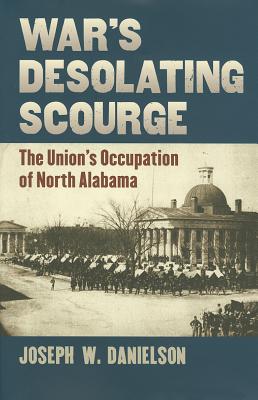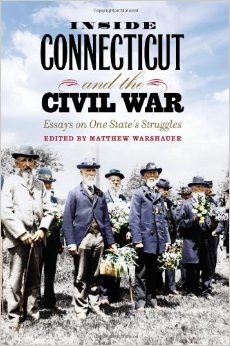War’s Desolating Scourge: The Union’s Occupation of North Alabama by Joseph W. Danielson. University of Kansas Press, 2012. Cloth, ISBN: 0700618449. $34.95.
 War’s Desolating Scourge is a fascinating study of the Federal occupation of North Alabama, and the continued defiance of loyal Confederates in the face of shifting political and military aims. Much focus has been placed upon the divisions within the Confederacy and, specifically, the influence of regionalism on loyalties during the war. This narrative has highlighted the struggle between unconditional unionists and the Confederate government, a conflict that reflected animosity between the slave-owning classes and men and women from areas with only a tentative connection to the institution. As the tides of war shifted, however, loyal rebels struggled as the enemy encroached into their homes and southern responses to these invasions yielded ever-harsher Federal policies towards Confederate sympathizers. As a case study on an area often believed to be a hotbed for unconditional unionism, War’s Desolating Scourge forces us to reconsider assumptions of loyalty from within the Confederacy, while simultaneously illuminating the inadequacies of Federal policy towards the South during the early years of the war.
War’s Desolating Scourge is a fascinating study of the Federal occupation of North Alabama, and the continued defiance of loyal Confederates in the face of shifting political and military aims. Much focus has been placed upon the divisions within the Confederacy and, specifically, the influence of regionalism on loyalties during the war. This narrative has highlighted the struggle between unconditional unionists and the Confederate government, a conflict that reflected animosity between the slave-owning classes and men and women from areas with only a tentative connection to the institution. As the tides of war shifted, however, loyal rebels struggled as the enemy encroached into their homes and southern responses to these invasions yielded ever-harsher Federal policies towards Confederate sympathizers. As a case study on an area often believed to be a hotbed for unconditional unionism, War’s Desolating Scourge forces us to reconsider assumptions of loyalty from within the Confederacy, while simultaneously illuminating the inadequacies of Federal policy towards the South during the early years of the war.
“North Alabama,” Danielson notes, “is not often thought of as a bastion of southern or Confederate nationalism” (2). Like most southern states, the population was divided in the wake of Lincoln’s election in 1860. North Alabama was economically and socially linked to Tennessee more so than the southern portion of the state, and unionism there reflected a very real fear that if the Border States were to remain in the Union, the citizens of North Alabama could potentially take the brunt of a Federal invasion of the South. The influence of cooperationists as well as the relatively low number of slaves in the region, only 63,500 or 14.6 percent of the state’s slave population, have led historians to misconstrue the true political orientation of North Alabama (9). The fear that immediate secession would “lead to economic, social, and political chaos,” was, however, a short lived phenomenon (14). Alabama voted to leave the Union in January 1861, and while some in the northern part of the state still questioned the feasibility of this measure, Danielson argues that attitudes shifted almost entirely in favor of secession following the attack on Fort Sumter (21).
Understanding Northern Alabama as a bastion of Confederate sympathy is a vital component of Danielson’s primary argument that this region became the testing ground for northern policies concerning southern civilians. The Union invasion of Alabama began in early April 1862 and was centered on the capture of the Memphis-Charleston Railroad. Confederate defenders were scarce and General Ormsby Mitchel and his Third Division, Army of the Ohio, easily captured and secured their objectives and began the Federal occupation of this region (26-28). As Danielson illustrates, Union officers and their men struggled with the realties that came with managing a hostile population. It became increasingly clear that the lenient and conciliatory Federal policy toward southern civilians was insufficient to reestablish control over these areas. Open defiance by Confederate citizens led to reprisals by Union troops, many of whom believed that “conciliation was conditional upon . . . civilians’ acceptance of Union overtures” (46). Despite pressure from Washington for reconciliation, open animosity existed between troops and civilians and reflected both political issues surrounding emancipation and personal conflict over foraging. Union measures in Alabama in 1862 were a reaction to steadfast Confederate sympathy throughout the region and reflected a frustration that stemmed from Lincoln’s own misconception of southern loyalties. By the winter 1862-63, however, “Northern citizens and soldiers had come to demand a destructive brand of warfare to bring the Confederate home front to its knees” and the renewed Union occupation eventually brought southern sympathizers to their knees (118).
War’s Desolating Scourge provides such an excellent analysis of the shifting ideologies underpinning southern occupation because Danielson has worked diligently to narrate causes and effects from both northern and southern perspectives. He contextualizes Federal and Confederate responses and reactions as products of both national policy and local events, which serves as an effective means of illustrating how soldiers and civilians contended with the very real, day-to-day struggles of occupation. Furthermore, Danielson’s incorporation of women and slaves in this study illuminates the important experiences of two groups impacted by local policy but often left out of the historical narrative due to lack of sources or their relative obscurity, at least when compared to the public exploits of soldiers or political figures. Finally, the author makes very clear the convergence of local experiences and broader political policy, which also makes this text a praiseworthy analysis of Abraham Lincoln’s shifting views of Confederates civilians as the war progressed. On the whole, War’s Desolating Scourge is a welcome addition to the historiography. Supplementing and expanding our understanding of the wartime interaction between soldiers and civilians in occupied areas of the Confederacy, this book underscores the important role that case studies might play in helping historians to better identify and understand the impact of the Civil War as a local, as well as a national conflict.
Ryan Keating is a Ph.D. Candidate in History at Fordham University and his first book, “Full-Fledged Volunteer Soldiers of Uncle Sam”: Irish Soldiers and their Communities in America’s Civil War, is currently under contract with Fordham University Press.
